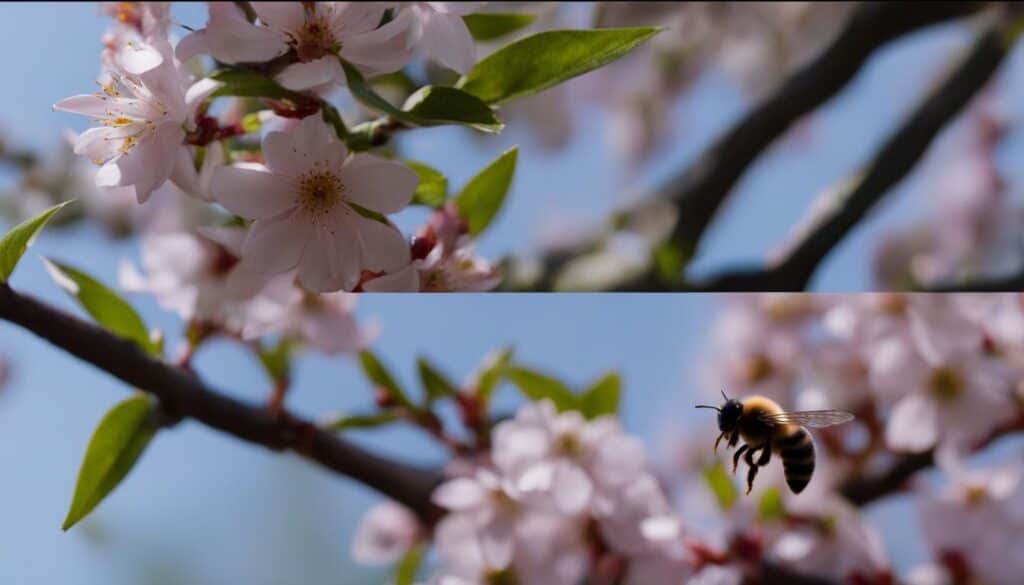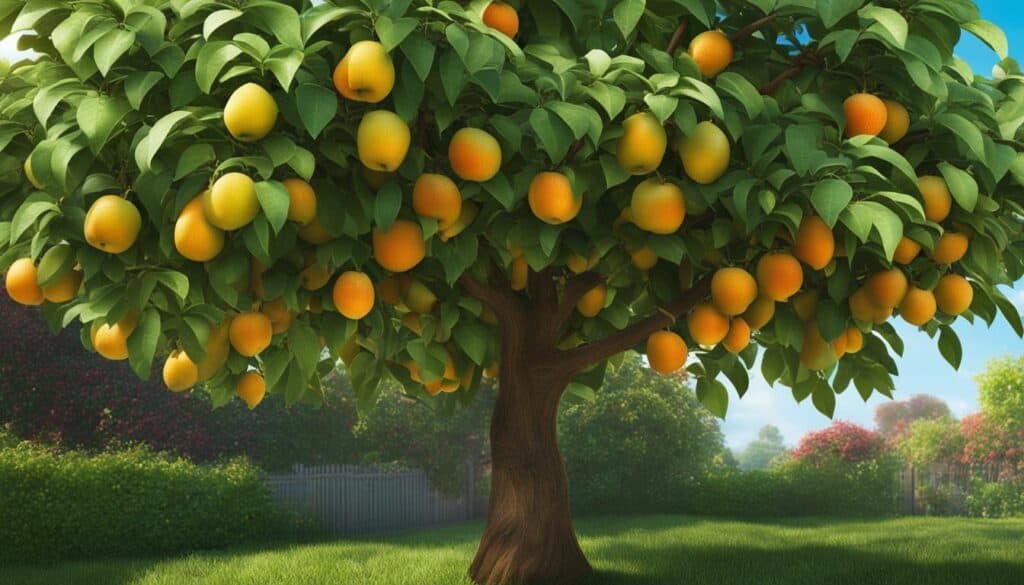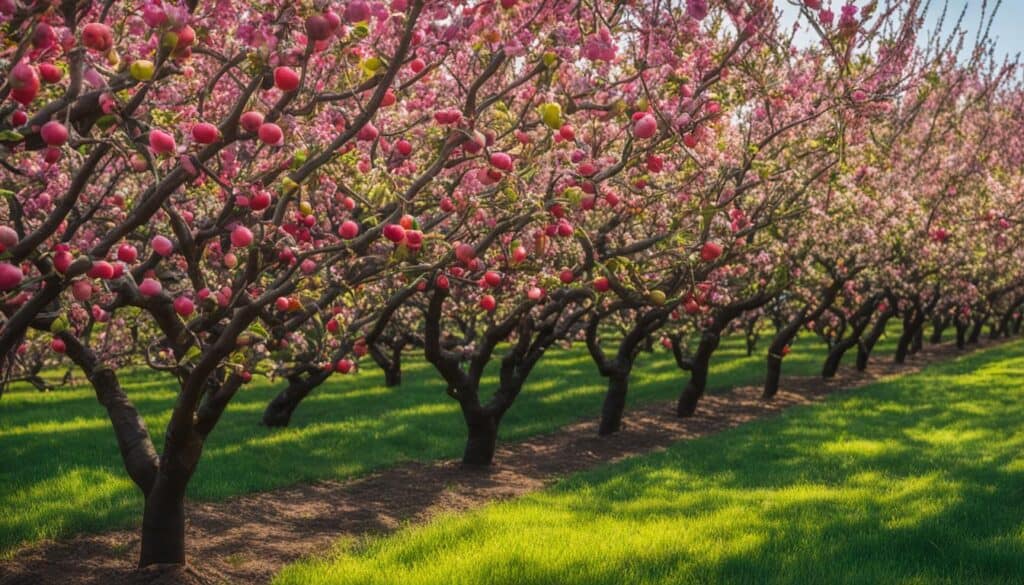Fruit trees are a popular addition to backyard gardens, offering shade and the opportunity to harvest fresh and delicious fruits. However, before planting a fruit tree, it’s important to consider certain factors. The size of your space is crucial in determining the type of tree to choose. If you have limited space, dwarf or semi-dwarf fruit trees are more suitable, as they can be maintained at a height of 8 to 12 feet.
Additionally, you might want to consider whether you prefer an evergreen tree, which retains its leaves year-round, or a deciduous tree, which sheds its leaves during certain seasons. Another important consideration is the climate in your area, as some fruit trees require specific conditions, such as a certain number of chill hours, to produce fruit. Lastly, cross-pollination may be necessary for some fruit tree varieties, so it’s important to check whether a tree requires a nearby pollinator.
Key Takeaways:
- Consider the size of your space when choosing a fruit tree variety.
- Decide whether you prefer an evergreen or deciduous tree.
- Take into account the climate requirements of different fruit tree varieties.
- Check if cross-pollination is necessary for the fruit tree you’re interested in.
- Do thorough research to choose the right fruit tree for your specific circumstances.
Factors to Consider When Choosing Fruit Tree Varieties
When it comes to selecting fruit tree varieties, several factors should be taken into consideration. First and foremost, you need to decide whether you prefer deciduous or evergreen fruit trees. Deciduous trees shed their leaves in the fall, while evergreen trees maintain their leaves throughout the year. This choice will depend on your personal preference and the overall look you want to achieve in your garden.
Apples, peaches, cherries, pears, and plums are some of the most popular fruit tree varieties. Each type of fruit offers its unique taste and characteristics, so it’s essential to consider your flavor preferences when making a selection. Whether you crave the crisp sweetness of an apple or the juicy tang of a cherry, there’s a wide range of options to suit every palate.
Additionally, you may want to think about whether you prefer perennial fruit trees or deciduous ones. Perennial fruit trees continue to bear fruit year after year, providing a consistent harvest. On the other hand, deciduous fruit trees require replanting each season but offer the opportunity to experiment with different varieties and flavors.
Finally, choosing fruit tree varieties that are well-suited to your climate and soil conditions is crucial for success. Different types of fruit trees have specific environmental requirements, such as the number of chill hours they need to set fruit. Conduct research or consult with local gardening experts to ensure that the varieties you select will thrive in your area.
By considering factors such as tree type, fruit preference, perennial or deciduous nature, and climate suitability, you can make an informed decision when choosing fruit tree varieties. This will lead to a bountiful harvest and a garden filled with delicious and beautiful fruits.
Popular Fruit Tree Varieties
| Fruit Tree Variety | Type | Flavor |
|---|---|---|
| Apple | Deciduous | Crunchy, sweet or tart |
| Peach | Deciduous | Juicy, sweet |
| Cherry | Deciduous | Tangy, sweet |
| Pear | Deciduous | Buttery, sweet |
| Plum | Deciduous | Juicy, sweet or tart |
Understanding Hardiness Zones and Chill Hours
The United States Department of Agriculture has classified different regions into hardiness zones based on their climate conditions. These zones help determine which plants and trees can thrive in a particular area. It’s important to know your hardiness zone when choosing fruit trees, as certain varieties may not survive extreme temperatures in certain zones.
Additionally, some fruit trees require a certain number of chill hours, which are hours with temperatures below 45 degrees Fahrenheit, to set fruit. This is especially important for trees like apples, peaches, and cherries, which rely on a period of dormancy during the winter to produce a bountiful harvest in the following season.
Before purchasing a fruit tree, it’s crucial to research the specific requirements of the variety you’re interested in and ensure that it is suitable for your hardiness zone and chill hour conditions. By understanding your local climate and the needs of the fruit trees you want to grow, you can create an optimal environment for healthy growth and abundant fruit production.
I always make sure to check my hardiness zone and the required chill hours before selecting fruit trees for my garden. It’s essential to create the right conditions for the trees to thrive and produce a plentiful harvest.
The Benefits of Evergreen Fruit Trees
Evergreen fruit trees offer a multitude of advantages for gardeners. Not only do they provide a bountiful harvest of delicious fruits but also bring year-round greenery to your garden, even during the winter months. This is particularly appealing for those seeking both shade and fruit-bearing trees. The enduring beauty of evergreen trees lies in their ability to retain their leaves throughout the year, adding visual interest and a touch of perennial beauty to any landscape.
With their continuous greenery, evergreen fruit trees offer more than just aesthetic appeal. The dense foliage of these trees serves as a natural privacy screen, shielding your garden from prying eyes. Additionally, the abundant leaves provide natural noise reduction, creating a peaceful and tranquil environment in your outdoor space.
“The year-round greenery and beauty of evergreen fruit trees make them a popular choice among gardeners.”
Whether you’re planting a backyard orchard or simply want to incorporate fruit-bearing trees into your garden, evergreen varieties offer a range of benefits. Their ability to provide year-round greenery and preserve their leaves adds a touch of beauty and elegance to any landscape. So, consider adding evergreen fruit trees to your gardening plans and enjoy their year-round benefits.
Ensuring Cross Pollination for Fruit Tree Success
Cross pollination plays a crucial role in the successful growth and fruit production of fruit trees. It involves the transfer of pollen from one tree to the flowers of another tree of the same species. This process is essential for fruit set and ensuring a good harvest. Some fruit tree varieties require cross pollination with a compatible pollinator to produce fruit effectively.
To determine if a fruit tree requires cross pollination, check the tag or label of the tree you’re considering. It will indicate whether the tree is self-pollinating or if it requires a compatible pollinator. Self-pollinating trees are capable of producing fruit on their own, while others need the assistance of another tree for pollination.
If your fruit tree requires cross pollination, it’s important to plant compatible varieties in close proximity. This proximity allows for the transfer of pollen between trees, maximizing the chances of successful cross pollination and increasing the likelihood of a bountiful fruit harvest. It’s recommended to plant the pollinator tree within 50 feet of the main tree to ensure effective cross pollination.
| Tree Variety | Pollination Type | Compatible Pollinator Varieties |
|---|---|---|
| Apple | Typically requires cross pollination | Gala, Granny Smith, Fuji |
| Peach | Many self-pollinating varieties available | Nectarine, Redhaven, Elberta |
| Cherry | Most varieties require cross pollination | Bing, Stella, Rainier |
Note: The table above provides examples of fruit tree varieties and their pollination types. Always consult the specific requirements of the varieties you are planting to ensure proper cross pollination.
Proper cross pollination not only ensures fruitful harvests, but it also promotes genetic diversity within the fruit tree population. This diversity can lead to improved disease resistance and overall tree health. If you’re uncertain about the compatibility of fruit tree varieties, a quick internet search or consultation with a local gardening expert can provide the necessary information to make informed planting decisions.

The Time it Takes for Fruit Trees to Produce
The time it takes for a fruit tree to produce can vary depending on several factors.
Most container-sized fruit trees that are purchased from nurseries or garden centers are grafted, meaning they are joined with rootstock from a different tree. These grafted trees tend to produce fruit more quickly, often within the first few years after planting.
If you choose to grow a fruit tree from seed, however, it can take significantly longer for the tree to reach maturity and produce fruit. For example, an avocado tree grown from seed may take between 7 to 10 years to fruit, while a grafted tree can begin bearing fruit in as little as one to two years.
If you’re eager to enjoy the benefits of fruit trees sooner rather than later, selecting an established grafted variety is recommended.

When it comes to the time it takes for fruit trees to produce, grafted trees have a clear advantage over seed-grown trees. The process of grafting involves combining the desired fruiting variety with a rootstock that provides necessary qualities such as disease resistance and vigor. This allows grafted trees to start producing fruit earlier, as they benefit from the established root system of the rootstock. Seed-grown trees, on the other hand, need more time to develop their root system and reach maturity before they can produce fruit.
Here’s a table summarizing the average time it takes for some common fruit trees to produce:
| Fruit Tree | Time to Fruit (Grafted) | Time to Fruit (Seed-grown) |
|---|---|---|
| Apple | 2-4 years | 4-6 years |
| Peach | 1-3 years | 3-5 years |
| Cherry | 2-4 years | 5-7 years |
| Pear | 3-5 years | 5-7 years |
As you can see, grafted trees generally have a shorter time to fruit compared to seed-grown trees. However, it’s important to note that these timeframes are general estimates and can vary depending on specific growing conditions and the health of the tree.
Whether you choose grafted or seed-grown fruit trees, the anticipation of waiting for that first harvest is part of the joy of gardening. By understanding the time it takes for fruit trees to produce and making informed decisions about your tree selection, you can ensure that you’ll be enjoying the delicious fruits of your labor in no time!
Dwarf Fruit Trees with Full-Size Flavor
As gardening trends shift towards smaller spaces and urban gardens, dwarf fruit trees have gained popularity for their compact size and suitability for limited areas. However, gardeners often worry that these smaller trees may lack the full flavor of their larger counterparts. Thankfully, advancements in breeding have led to the development of full-flavor varieties specifically designed for dwarf fruit trees, providing the perfect balance between taste and size.
These specially bred varieties of dwarf fruit trees offer the same delicious flavor as their full-size counterparts while maintaining a compact and manageable size. Now, you can enjoy the mouthwatering taste of your favorite fruits without sacrificing valuable space in your garden. Some notable examples of these full-flavor dwarf fruit tree options include:
- ‘Apple Babe’ apple
- ‘Nagami’ kumquat
- ‘Compact Stella’ cherry
- ‘Honey Babe’ miniature peach
- ‘Pixie-Cot’ apricot
- ‘Violette de Bordeaux’ fig
Each of these varieties has been carefully selected and bred to offer exceptional flavor in a compact form. Whether you’re craving the crispness of an apple, the tangy sweetness of a kumquat, or the juicy richness of a cherry, there is a full-flavor dwarf fruit tree variety to suit your taste buds.
With these compact fruit tree options, you can create a bountiful and flavor-filled garden in even the smallest of spaces. Embrace the convenience and beauty of these dwarf fruit trees, and savor the luscious flavors they bring to your table.

Why Choose Dwarf Fruit Trees with Full-Size Flavor?
“With full-flavor varieties, you don’t have to compromise on taste when opting for compact fruit trees. The carefully selected genetic traits of these dwarf trees ensure that you can enjoy the same delectable flavors as their larger counterparts, making them the perfect choice for small gardens and urban environments.” – Gardening Expert
Additional Benefits of Growing Fruit Trees
Growing fruit trees offers more than just the satisfaction of harvesting fresh fruits. These trees provide an array of additional benefits that contribute to the overall well-being of your garden and the environment. Let’s explore some of these remarkable advantages:
- Shade and Comfort: Fruit trees serve as natural shade providers, which can be particularly advantageous in hot climates or during the scorching summer months. The canopy of these trees offers a cool and inviting space to relax and enjoy the outdoors.
- Ornamental Beauty: In addition to their fruit-bearing capabilities, fruit trees add a touch of beauty and color to your landscape. Their blossoms in spring and vibrant foliage throughout the year create a visually appealing and eye-catching focal point in any garden.
- Sustainable Resource: Fruit trees offer multiple practical uses beyond their fruits. The wood from these trees can be utilized for lumber, poles, and firewood, providing a sustainable source of materials for various purposes.
- Environmental Benefits: Fruit trees play a crucial role in soil improvement and contribute to reforestation efforts. Their extensive root systems help prevent soil erosion and enhance soil fertility, creating a healthier and more robust ecosystem. By planting fruit trees, you actively contribute to environmental conservation and the restoration of natural habitats.
- Income Generation: If you have an abundance of fruit from your trees or possess value-added skills, you can explore opportunities to turn your harvest into income. Selling excess fruits or creating value-added products such as jams, jellies, or dried fruits can be a rewarding way to generate extra income and share the delicious rewards of your garden.
All in all, growing fruit trees is a multi-purpose endeavor that extends far beyond the simple pleasure of picking fresh fruits. These trees enhance the aesthetics of your outdoor space, provide a sustainable resource, contribute to a healthier environment, and even offer potential financial benefits. Experience the joy of growing fruit trees and reap the multitude of rewards they offer.

| Benefits of Growing Fruit Trees | Keywords |
|---|---|
| Shade and Comfort | shaded gardens, climate relief |
| Ornamental Beauty | garden aesthetics, vibrant foliage |
| Sustainable Resource | lumber, poles, firewood |
| Environmental Benefits | soil improvement, reforestation |
| Income Generation | selling fruits, value-added products |
Conclusion
After exploring the world of fruit trees, it is clear that they bring a multitude of benefits to any garden. From the joy of harvesting and enjoying fresh fruits to the beauty they add to the landscape, fruit trees have much to offer.
Whether you opt for evergreen or deciduous varieties, dwarf or full-size trees, it is important to consider factors such as hardiness zones, chill hours, and cross pollination requirements. This ensures that your fruit trees thrive in their specific environment and produce abundant fruits.
While the time it takes for fruit trees to reach maturity and bear fruit can vary, selecting grafted varieties can accelerate the process and shorten the waiting time for your first harvest. Additionally, it’s important to remember that the benefits of fruit trees go beyond fruit production. They provide shade, serve as a source of sustainable materials, and contribute to soil improvement and reforestation, making them valuable assets for a greener planet.
By carefully selecting and nurturing fruit trees, you can create a sustainable and fruitful garden that brings beauty, nourishment, and joy for years to come. Whether it’s the vibrant blooms in spring, the lush foliage throughout the year, or the bountiful harvest in the summer, fruit trees are a true investment in both your garden and the environment.
FAQ
Are fruit trees evergreen?
Some fruit trees are evergreen, retaining their leaves year-round, while others are deciduous and shed their leaves during certain seasons.
What factors should I consider when choosing fruit tree varieties?
When choosing fruit tree varieties, consider whether you prefer evergreen or deciduous trees and the type of fruit and taste preferences. Additionally, consider whether you prefer perennial fruit trees or deciduous trees that require replanting each season.
How do hardiness zones and chill hours affect fruit tree selection?
Hardiness zones help determine which fruit trees can thrive in your area, while chill hours are important for certain fruit trees to set fruit. Research the specific requirements of the variety you’re interested in to ensure it is suitable for your hardiness zone and chill hour conditions.
What are the benefits of evergreen fruit trees?
Evergreen fruit trees provide year-round greenery, shade, and visual interest to your garden. They also offer natural privacy screening and noise reduction.
How important is cross pollination for fruit tree success?
Cross pollination is important for some fruit tree varieties to ensure successful fruit production. Consult the tag or label of the tree you’re considering to determine if it requires a pollinator.
How long does it take for fruit trees to produce?
The time it takes for fruit trees to produce can vary. Grafted trees tend to produce fruit more quickly, often within a few years, while trees grown from seed can take significantly longer.
Can dwarf fruit trees have full-size flavor?
Yes, there are full-flavor varieties available for dwarf fruit trees. These varieties have been bred to provide the same delicious taste as their larger counterparts while maintaining a compact size.
What are the additional benefits of growing fruit trees?
Fruit trees provide shade, beauty, and can be used for lumber and firewood. They also contribute to soil improvement, reforestation, and can provide potential income through selling excess fruits or value-added products.
Conclusion
Fruit trees are a valuable addition to any garden, offering fresh fruits, shade, and numerous other benefits. Consider your space, climate, and preferences when choosing fruit tree varieties, and enjoy the rewards of growing your own fruit.





Leave a Reply